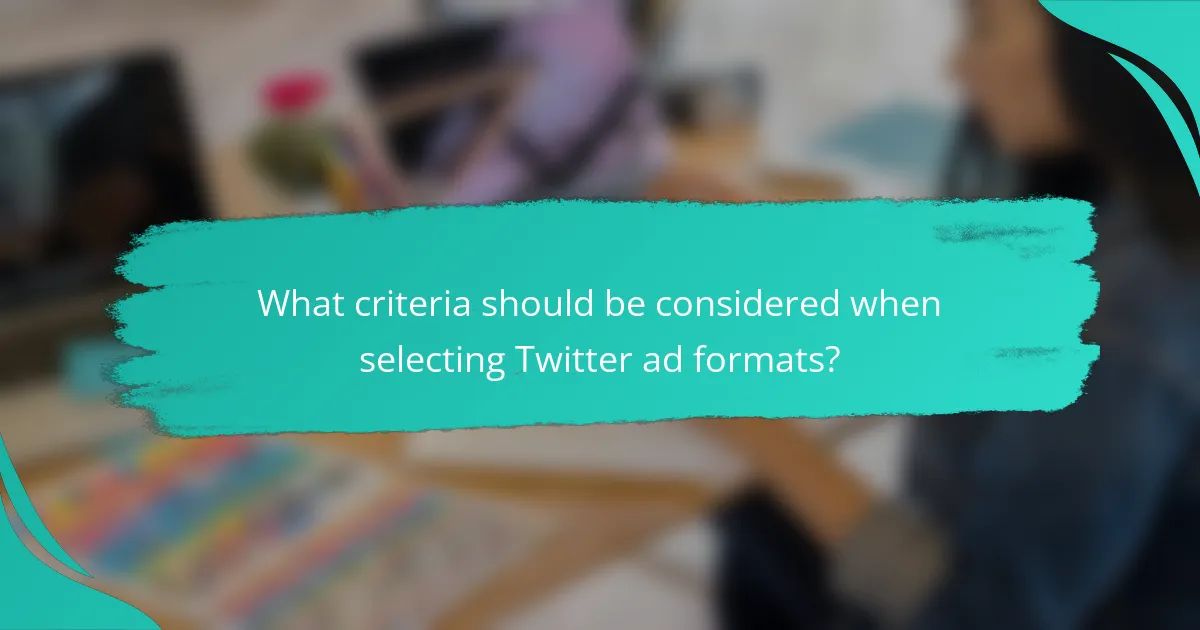Creating effective Twitter ad copy is essential for capturing your audience’s attention and driving engagement. By focusing on clear messaging, strong calls-to-action, and appealing visuals, you can enhance your ad’s impact. Additionally, employing strategies like trending hashtags and A/B testing will help refine your approach, while analyzing key performance metrics will ensure you measure your success accurately.

How to create effective Twitter ad copy?
Creating effective Twitter ad copy involves crafting messages that are clear, engaging, and tailored to your audience’s interests. Focus on concise language, strong calls-to-action, and appealing visuals to maximize engagement and drive results.
Use concise language
Concise language is crucial in Twitter ads due to the platform’s character limit. Aim for brevity while ensuring your message remains clear and impactful. Use simple words and avoid jargon to enhance comprehension.
Consider using short sentences and bullet points to break up text. For example, instead of saying “We offer a wide range of products to meet your needs,” say “Explore our diverse products.” This approach captures attention quickly.
Incorporate strong calls-to-action
Strong calls-to-action (CTAs) prompt users to take immediate action, such as visiting a website or making a purchase. Use action-oriented phrases like “Shop Now,” “Learn More,” or “Sign Up Today” to encourage engagement.
Position your CTA prominently within the ad copy. For instance, placing it at the end of your message can reinforce the desired action. Experiment with different CTAs to see which resonates best with your audience.
Utilize engaging visuals
Visuals play a significant role in capturing attention on Twitter. Use high-quality images, videos, or GIFs that complement your ad copy and convey your message effectively. Engaging visuals can increase click-through rates significantly.
Ensure that your visuals align with your brand identity and the message of your ad. For example, if promoting a summer sale, use bright, vibrant images that evoke a sense of fun and excitement. This helps create a cohesive experience for viewers.
Tailor messages to target audience
Understanding your target audience is essential for crafting relevant Twitter ad copy. Tailor your messages based on demographics, interests, and behaviors to resonate with your audience. This personalization can enhance engagement and conversion rates.
Utilize Twitter’s targeting options to reach specific groups. For example, if your product appeals to young professionals, focus on language and visuals that reflect their lifestyle. Regularly analyze performance metrics to refine your approach and improve results.

What are the best practices for Twitter ad engagement?
To enhance Twitter ad engagement, focus on creating compelling content that resonates with your audience. Utilize strategies like trending hashtags, active user interaction, and systematic A/B testing to refine your approach and maximize impact.
Leverage trending hashtags
Incorporating trending hashtags into your Twitter ads can significantly increase visibility and engagement. Research current trends relevant to your brand and audience, and integrate these hashtags to join ongoing conversations.
For best results, limit the number of hashtags to one or two per tweet to avoid clutter. Monitor hashtag performance to identify which ones drive the most engagement and adjust your strategy accordingly.
Engage with user comments
Responding to user comments on your ads fosters a sense of community and encourages further interaction. Acknowledge positive feedback and address concerns promptly to build trust and loyalty among your audience.
Consider setting aside time daily to engage with comments. This not only boosts engagement metrics but also provides valuable insights into customer preferences and pain points.
Run A/B tests for optimization
A/B testing allows you to compare different versions of your ads to determine which performs better. Test elements such as ad copy, images, and call-to-action buttons to identify what resonates most with your audience.
Start with small sample sizes and gradually scale up once you identify winning variations. Regularly revisit your tests to ensure your ads remain effective as audience preferences evolve.

How to measure success of Twitter ads?
Measuring the success of Twitter ads involves analyzing various performance metrics that indicate how well your ads are achieving their goals. Key metrics include click-through rates, conversion rates, and engagement rates, which provide insights into audience interaction and overall effectiveness.
Track click-through rates
Click-through rates (CTR) measure the percentage of users who click on your ad after seeing it. A higher CTR indicates that your ad is compelling and relevant to your target audience. Aim for a CTR of around 1-3%, but this can vary based on industry and ad type.
To track CTR, use Twitter’s analytics tools, which provide detailed reports on ad performance. Regularly review these metrics to identify trends and adjust your ad copy or targeting strategies as needed.
Analyze conversion metrics
Conversion metrics show how many users take a desired action after clicking your ad, such as making a purchase or signing up for a newsletter. This is crucial for determining the return on investment (ROI) of your ad spend. A conversion rate of 2-5% is generally considered good, but this can differ based on your specific goals.
Utilize Twitter’s conversion tracking feature to set up specific actions you want to measure. This allows you to see which ads are driving the most conversions and helps you optimize your campaigns accordingly.
Monitor engagement rates
Engagement rates reflect how users interact with your ad, including likes, retweets, and replies. High engagement rates suggest that your content resonates with your audience, which can lead to increased brand awareness and loyalty. Aim for engagement rates of 0.5-2% as a benchmark.
To monitor engagement, regularly check Twitter analytics for insights on how users are responding to your ads. Use this data to refine your messaging and creative elements to boost overall engagement and effectiveness.

What tools can enhance Twitter ad performance?
Several tools can significantly improve the performance of your Twitter ads by streamlining scheduling, enhancing design, and providing insightful analytics. Utilizing the right combination of these tools can lead to better engagement and higher conversion rates.
Use Hootsuite for scheduling
Hootsuite is an effective tool for scheduling your Twitter ads, allowing you to plan campaigns in advance and post at optimal times. This ensures your ads reach your target audience when they are most active, which can lead to increased engagement.
To maximize effectiveness, consider scheduling posts during peak hours, typically early morning or late afternoon on weekdays. Regularly review engagement metrics to adjust your posting times based on audience behavior.
Utilize Canva for ad design
Canva is a user-friendly design tool that helps create visually appealing Twitter ads without the need for advanced graphic design skills. It offers a variety of templates specifically tailored for social media, making it easy to produce professional-looking ads quickly.
When designing ads, focus on clear messaging and eye-catching visuals. Use high-quality images and maintain brand consistency in colors and fonts. Aim for simplicity; ads that are cluttered can detract from the main message and reduce engagement.
Employ Google Analytics for tracking
Google Analytics is essential for tracking the performance of your Twitter ads, providing insights into user behavior and conversion rates. By linking your Twitter account to Google Analytics, you can monitor traffic generated from your ads and assess their effectiveness.
Set up specific goals to measure conversions, such as sign-ups or purchases, and regularly analyze the data to identify trends. This information can guide future ad strategies, helping you allocate resources more effectively and optimize your campaigns for better results.

What criteria should be considered when selecting Twitter ad formats?
When selecting Twitter ad formats, consider factors such as your target audience’s preferences, the specific objectives of your campaign, and the types of content that resonate best with users. Each format has unique strengths that can align with different marketing goals.
Assess audience preferences
Understanding your audience’s preferences is crucial in choosing the right Twitter ad format. Analyze engagement metrics from previous campaigns to identify which formats—like image ads, video ads, or polls—your audience interacts with most. For instance, if your audience tends to engage more with video content, prioritize video ads to enhance engagement.
Additionally, consider conducting surveys or utilizing Twitter’s analytics tools to gather insights on what types of content your audience finds appealing. Tailoring your ad formats to match these preferences can significantly improve your campaign’s effectiveness.
Evaluate campaign objectives
Your campaign objectives will heavily influence the choice of Twitter ad formats. If your goal is brand awareness, formats like promoted tweets or trends can be effective in reaching a broad audience. Conversely, if you aim to drive conversions, consider using website cards or app install ads that encourage immediate action.
Define clear objectives—such as increasing website traffic, generating leads, or boosting engagement—and select ad formats that align with these goals. Regularly review performance metrics to adjust your strategy and optimize for better results.

What emerging trends are shaping Twitter advertising?
Emerging trends in Twitter advertising are primarily driven by the increasing importance of video content and the integration of artificial intelligence for personalized experiences. These trends are reshaping how brands engage with their audiences, making advertising more dynamic and tailored.
Increased focus on video content
Video content is becoming a central element in Twitter advertising strategies as it captures attention more effectively than static images or text. Brands are encouraged to create short, engaging videos that convey their message quickly, ideally within a few seconds to retain viewer interest.
To maximize impact, consider using eye-catching visuals and clear calls to action. A/B testing different video formats can help determine what resonates best with your target audience. Aim for videos that are under 30 seconds for optimal engagement.
Integration of AI for personalization
The integration of AI in Twitter advertising allows brands to deliver personalized content based on user behavior and preferences. This technology analyzes vast amounts of data to tailor ads that are more relevant to individual users, increasing the likelihood of engagement.
Brands should leverage AI tools to segment their audience effectively and create targeted campaigns. Utilizing dynamic ad formats that adjust based on user interactions can enhance personalization. However, it’s essential to balance personalization with privacy considerations to maintain user trust.
